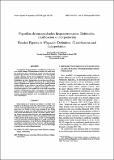Por favor, use este identificador para citar o enlazar a este item:
http://hdl.handle.net/10261/234235COMPARTIR / EXPORTAR:
 SHARE SHARE
 CORE
BASE CORE
BASE
|
|
| Visualizar otros formatos: MARC | Dublin Core | RDF | ORE | MODS | METS | DIDL | DATACITE | |

| Título: | Figurillas de encapuchados hispanorromanos: Definición, clasificación e interpretación |
Otros títulos: | Hooded Figures in Hispania: Definition, Classification and Interpretation | Autor: | Salido Domínguez, Javier CSIC ORCID; Rodríguez Ceballos, Mariano | Palabras clave: | Arqueología romana Hispania Religión Magia Tintinnabula Roman archeology Religion Magic |
Fecha de publicación: | 2015 | Citación: | Archivo Español de Arqueologia 88: 105-125 (2015) | Resumen: | [ES] Las figurillas de encapuchados o cucullati fueron frecuentes en el mundo romano. El característico cucullus fue usado tanto por hombres de baja consideración social como por personas pudientes que deseaban no ser reconocidos; y con esta capucha y manto-capucha, dotados de un significado especial, fueron también representados genii, seres divinos y otras pequeñas divinidades, así como figuraciones que servían como ahuyen-tadores de espíritus y símbolos protectores. En el ámbito de la antigua Hispania estas representaciones han pasado bastante desapercibidas, lo que obedece a un problema de publicación más que de una ausencia en el registro arqueológico. La revi-sión historiográfica de las esculturillas de cucullati de terracota y bronce, documentadas hasta el momento en la Península Ibérica, nos permite analizar su procedencia, características técnicas, aportando hipótesis sobre su significado en su con-texto arqueológico. [EN] Representations of hooded individuals or cucullati were frequent in the Roman world. The characteristic cucullus was worn by both male individuals of a low social rank and patri-cians who wore hoods to avoid being recognised; also divine beings known as genii and other divinities were represented with a hood and cloak-hood, in this case with a special mean-ing. When studying ancient Hispania, such representations have often gone unobserved due to publication problems rather than to their absence in the archaeological record. A historiographic review of terracotta and bronze figurines or small sculptures of cucullati documented so far in the Iberian Peninsula has made it possible to analyse their origin, character, and the materials used in their manufacturing, in such a way that new knowledge is gained from a context-based analysis. |
Versión del editor: | http://dx.doi.org/10.3989/aespa.088.015.006 | URI: | http://hdl.handle.net/10261/234235 | DOI: | 10.3989/aespa.088.015.006 | Identificadores: | doi: 10.3989/aespa.088.015.006 issn: 1988-3110 |
| Aparece en las colecciones: | (EEHAR) Artículos |
Ficheros en este ítem:
| Fichero | Descripción | Tamaño | Formato | |
|---|---|---|---|---|
| Figurillas de encapuchados.pdf | 1,93 MB | Adobe PDF |  Visualizar/Abrir |
CORE Recommender
Page view(s)
151
checked on 22-abr-2024
Download(s)
161
checked on 22-abr-2024
Google ScholarTM
Check
Altmetric
Altmetric
NOTA: Los ítems de Digital.CSIC están protegidos por copyright, con todos los derechos reservados, a menos que se indique lo contrario.
